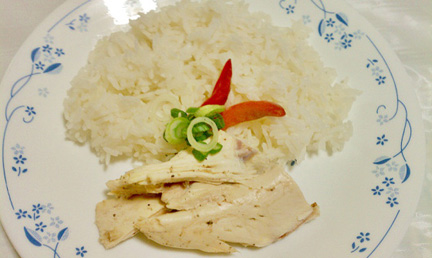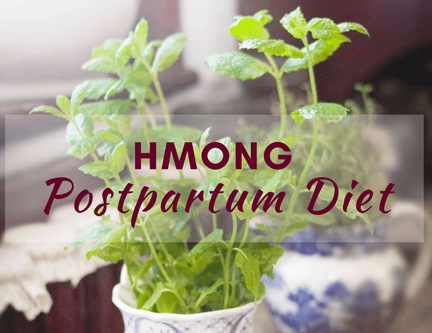Hmong Postpartum Diet
By Priscilla Yang
In the Hmong culture, it’s customary for women who just gave birth to complete a 30-day postpartum diet. Between being Americanized and progressive, it wasn’t appealing to me because the diet meant eating the same dish for 30 days; it sounded more like a punishment.
The purpose of the Hmong postpartum diet is to help cleanse and heal the body after labor. Additionally, caring for the postpartum body is supposed to help a woman’s body ease her way into menopause when it’s time for that chapter of her life.
My traditional mother reminded me each time I gave birth that I had to complete the diet. She would tell me how to do it but never actually told me why, except that it was good for me.
So what exactly does the diet consist of? Ideally, a woman is supposed to have three servings of freshly made boiled chicken and broth (made with special Hmong herbs that are grown specifically for postpartum care) with a side of fresh rice each day. It’s believed that consuming old-aged chicken can cause chest pains later on in life, so serving a woman young chicken is important. A woman’s husband or another family member is supposed to prepare each meal because the new mom’s only job for the next 30 days is to rest and care for her newborn. As far as beverages, she can only drink warm/hot water.
Why is the Hmong postpartum diet important? I learned that there’s an emphasis on fresh/hot food and water because Hmong people believe that it will help the body get rid of childbirth blood and bring in new blood, which will help her regain energy. Cold food/water will cause the body to retain old blood, which can contribute to a new mother being unhealthy and sick all the time. Additionally, the diet will help a new mom lose the weight she gained while pregnant as well as help her gain an appetite so she can nourish her body.
I didn’t complete the diet after my first two births, but when I became pregnant last year, I noticed that I had a much more difficult time with my pregnancy than I did with my first two children. I experienced excruciating body aches and the doctors told me early on that I had anemia (iron deficiency). When someone is anemic, their body doesn’t produce enough red blood cells needed to carry oxygen to their organs. In turn, they can become tired very easily, feel lightheaded or dizzy, and look very pale.
I started to wonder about the future and how important it was for me to take care of myself, especially my body. Perhaps the Hmong postpartum diet that has been apart of the Hmong culture for many generations was put in place for a reason. As I continued to learn more about the special diet, I found out that there are a variety of postpartum herbs, each one having a different purpose. Many of the postpartum herbs help increase energy, appetite, and iron levels. I decided before labor that I was going to stick to the diet to see if there really was a difference in my postpartum recovery.
I gave birth to my daughter in May and immediately began the diet. My family brought freshly prepared food while I was at the hospital. Many hospitals that have a lot of Hmong patients have become more sensitive to the postpartum cultural practices and offer boiled chicken and rice as a meal option if no one is able to bring freshly prepared food for them.
Two weeks postpartum, I noticed that recovery was much easier than it was during my first two pregnancies. By the end of the diet, I lost all the pregnancy weight I gained, plus a few more pounds. I felt energized and not groggy or heavy like I usually do when I eat whatever I want. Also, my iron levels increased and my doctor told me at my four-week check up that I was no longer considered anemic.
There were five important things that I drew from my experience:
- If you’re breastfeeding, it’s important to continue taking your prenatal vitamins so your newborn gets extra vitamins that they aren’t getting from your restricted diet.
- Take a stool softener regularly (normally prescribed by doctor) because it’s a high protein diet.
- Using a thermos to keep your water hot helps cut the time it takes to boil hot water.
- Having your spouse pre-package your herbs/chicken makes it easier and quicker to cook three meals a day.
- The diet gets easier the longer you do it; don’t give up.
The Hmong postpartum diet offers many health benefits after labor, whether you are a Hmong woman or not. The diet offers a good source of protein and carbs; don’t forget that the herbs help the body recover quicker. For those who aren’t sure where to buy herbs, check your local Hmong farmers markets and Hmong stores.













